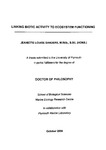Linking biotic activity to ecosystem functioning
| dc.contributor.author | Sanders, Jeanette Louise | |
| dc.contributor.other | School of Biological and Marine Sciences | en_US |
| dc.date.accessioned | 2011-09-26T13:10:32Z | |
| dc.date.available | 2011-09-26T13:10:32Z | |
| dc.date.issued | 2008 | |
| dc.date.issued | 2008 | |
| dc.identifier | Not available | en_US |
| dc.identifier.uri | http://hdl.handle.net/10026.1/688 | |
| dc.description | Merged with duplicate record 10026.1/2441 on 14.03.2017 by CS (TIS) | |
| dc.description.abstract |
The central theme of this thesis was the search for ecologically meaningful ways to quantify the relationships between the biota and ecosystem processes. This thesis investigated whether a "functional group" approach, that characterised the fauna according to similarities in their activities, could be successfully employed to quantifiably link species' performance to important ecosystem processes. Initially the abilities of traditional "trophic" and "bioturbatory" categories to characterise the estuarine macrobenthic fauna and discriminate between estuarine sites were examined. This thesis determined that the perceived inter-site similarity within an estuary varied according to the function being investigated and that the apparent associations between abiotic factors and biotic assemblages were also heavily influenced by the choice of functional classification. This study provided strong evidence that links between the macrobenthos and abiotic factors were most easily detected if the species were grouped according to their bioturbatory abilities. Thus, attempts to model the contribution of the estuarine macrofauna to sediment mixing throughout an estuary were pursued in preference to modelling trophic group distribution. This thesis identified limitations of existing "bioturbation" categories and hence, developed a novel classification system that incorporated species' activity rates, magnitude and location within the sediment. Strong evidence was found that estuarine macrobenthic communities should be treated as two separate assemblages: one shallow assemblage occupying surface and near surface layers, and one deep assemblage with the ability to exploit the sediment at greater depths. The two separate assemblages displayed different associations with the environmental factors examined in this study. By developing new functional groupings of species' behaviour, and treating shallow and deep assemblages as separate entities, this thesis was able to estimate the contribution of the biota to sediment mixing and successfully develop and validate generic predictive models of functional group distribution within the Tamar/Plym estuarine system. Since the functional groups themselves convey information about the magnitude of their effect and the sediment horizons impacted, this thesis represents an important advance in our ability to predict biological contribution to sediment mixing processes in estuarine ecosystems. | en_US |
| dc.description.sponsorship | Plymouth Marine Laboratory | |
| dc.language.iso | en | en_US |
| dc.publisher | University of Plymouth | en_US |
| dc.title | Linking biotic activity to ecosystem functioning | en_US |
| dc.type | Thesis | |
| dc.identifier.doi | http://dx.doi.org/10.24382/3591 |
Files in this item
This item appears in the following Collection(s)
-
01 Research Theses Main Collection
Research Theses Main


